Multi-Residue Screening of Pesticides in Aquatic Products Using High-Performance Liquid Chromatography-Tandem High-Resolution Mass Spectrometry
Abstract
:1. Introduction
2. Materials and Methods
2.1. Reagents
2.2. Sample Sources
2.3. Solution Preparation
2.4. Sample Preparation
2.5. Instrument Method
2.6. Method Optimization
2.6.1. Optimization of Solvents, Salts and Additives
2.6.2. Optimization of Cleanup
2.6.3. Optimization of Filter Membrane
2.7. Method Validation
2.7.1. Matrix Effect (ME)
2.7.2. Screening Detection Limit (SDL)
2.7.3. Accuracy and Precision
3. Results and Discussion
3.1. Optimization of Extraction Methods
3.1.1. Solvent
3.1.2. Salts
3.1.3. Effect of Additives in the Extractant
3.2. Optimization of the Cleanup Procedure
3.2.1. Low-Fat Fishery Products
3.2.2. Fat-Rich Aquatic Products
3.3. Effect of Filter Membrane
3.4. Method Performance
3.4.1. Matrix Effect
3.4.2. Screening Detection Limits
3.4.3. Recovery and Precision
3.5. Method Application and Characterization
4. Conclusions
Supplementary Materials
Author Contributions
Funding
Data Availability Statement
Conflicts of Interest
References
- Nsonga, A. Challenges and emerging opportunities for aquaculture development in zambia. Int. J. Fish. Aquat. Stud. 2014, 2, 232–237. [Google Scholar]
- Shen, Y.; Ma, K.; Yue, G.H. Status, challenges and trends of aquaculture in Singapore. Aquaculture 2021, 533, 736210. [Google Scholar] [CrossRef]
- Maulu, S.; Hasimuna, O.J.; Haambiya, L.H.; Monde, C.; Musuka, C.G.; Makorwa, T.H.; Munganga, B.P.; Phiri, K.J.; Nsekanabo, J.D. Climate Change Effects on Aquaculture Production: Sustainability Implications, Mitigation, and Adaptations. Front. Sustain. Food Syst. 2021, 5, 609097. [Google Scholar] [CrossRef]
- Zhang, H.; Sun, C.; Wang, Z.; Che, B. Seafood consumption patterns and affecting factors in urban China: A field survey from six cities. Aquac. Rep. 2021, 19, 100608. [Google Scholar] [CrossRef]
- Sabra, F.; Mehana, E.-S. Pesticides Toxicity in Fish with Particular Reference to Insecticides. Asian J. Agric. Food Sci. 2015, 3, 40–60. [Google Scholar]
- Salomon, M.; Markus, T.; Dross, M. Masterstroke or paper tiger—The reform of the EU’s Common Fisheries Policy. Mar. Policy 2014, 47, 76–84. [Google Scholar] [CrossRef]
- Cho, H.R.; Park, J.S.; Kim, J.; Han, S.B.; Choi, Y.S. Multiresidue method for the quantitation of 20 pesticides in aquatic products. Anal. Bioanal. Chem. 2015, 407, 9043–9052. [Google Scholar] [CrossRef]
- Golge, O.; Kabak, B. Determination of 115 pesticide residues in oranges by high-performance liquid chromatography–triple-quadrupole mass spectrometry in combination with QuEChERS method. J. Food Compos. Anal. 2015, 41, 86–97. [Google Scholar] [CrossRef]
- Shin, D.; Kim, J.; Kang, H.-S. Simultaneous determination of multi-pesticide residues in fish and shrimp using dispersive-solid phase extraction with liquid chromatography–tandem mass spectrometry. Food Control. 2021, 120, 107552. [Google Scholar] [CrossRef]
- Gan, J.; Lv, L.; Peng, J.; Li, J.; Xiong, Z.; Chen, D.; He, L. Multi-residue method for the determination of organofluorine pesticides in fish tissue by liquid chromatography triple quadrupole tandem mass spectrometry. Food Chem. 2016, 207, 195–204. [Google Scholar] [CrossRef]
- Molina-Ruiz, J.M.; Cieslik, E.; Cieslik, I.; Walkowska, I. Determination of pesticide residues in fish tissues by modified QuEChERS method and dual-d-SPE clean-up coupled to gas chromatography–mass spectrometry. Environ. Sci. Pollut. Res. 2015, 22, 369–378. [Google Scholar] [CrossRef]
- Choi, M.; Lee, I.-S.; Jung, R.-H. Rapid determination of organochlorine pesticides in fish using selective pressurized liquid extraction and gas chromatography–mass spectrometry. Food Chem. 2016, 205, 1–8. [Google Scholar] [CrossRef]
- López-Blanco, C.; Gómez-Alvarez, S.; Garrote, M.; Cancho-Grande, B.; Simal-Gandara, J. Determination of carbamates and organophosphorus pesticides by SDME-GC in natural water. Anal. Bioanal. Chem. 2005, 383, 557–561. [Google Scholar] [CrossRef]
- Kong, C.; Wang, Y.; Huang, Y.; Yu, H. Multiclass screening of >200 pharmaceutical and other residues in aquatic foods by ultrahigh-performance liquid chromatography-quadrupole-Orbitrap mass spectrometry. Anal. Bioanal. Chem. 2018, 410, 5545–5553. [Google Scholar] [CrossRef]
- Wang, S.-Y.; Kong, C.; Chen, Q.-P.; Yu, H.-J. Screening 89 Pesticides in Fishery Drugs by Ultrahigh Performance Liquid Chromatography Tandem Quadrupole-Orbitrap Mass Spectrometer. Molecules 2019, 24, 3375. [Google Scholar] [CrossRef] [Green Version]
- He, Z.; Wang, L.; Peng, Y.; Luo, M.; Wang, W.; Liu, X. Multiresidue analysis of over 200 pesticides in cereals using a QuEChERS and gas chromatography-tandem mass spectrometry-based method. Food Chem. 2015, 169, 372–380. [Google Scholar] [CrossRef]
- Samsidar, A.; Siddiquee, S.; Shaarani, S.M. A review of extraction, analytical and advanced methods for determination of pesticides in environment and foodstuffs. Trends Food Sci. Technol. 2018, 71, 188–201. [Google Scholar] [CrossRef]
- Wang, Q.-W.; Yang, G.-P.; Zhang, Z.-M.; Zhang, J. Optimization of sample preparation and chromatography for the determination of perfluoroalkyl acids in sediments from the Yangtze Estuary and East China Sea. Chemosphere Environ. Toxicol. Risk Assess. 2018, 205, 524–530. [Google Scholar] [CrossRef]
- GB 2763-2021; National Standard for Food Safety-Maximum Residue Limits for Pesticides in Food. National Health Commission: Beijing, China; Ministry of Agricultural and Rural Affairs: Beijing, China; State Administration of Market Regulation: Beijing, China, 2021. Available online: http://down.foodmate.net/standard/sort/3/108497.html (accessed on 18 December 2021).
- Wang, S.; Kong, C.; Wu, N.; Si, W.; Bai, B. H-beta zeolite-based dispersive solid-phase strategy for the multi-residue determination of pesticides. Anal. Chim. Acta 2022, 1227, 340327. [Google Scholar] [CrossRef]
- Huang, Y.; Shi, T.; Luo, X.; Xiong, H.; Min, F.; Chen, Y.; Nie, S.; Xie, M. Determination of multi-pesticide residues in green tea with a modified QuEChERS protocol coupled to HPLC-MS/MS. Food Chem. 2019, 275, 255–264. [Google Scholar] [CrossRef]
- Guidance Document on Analytical Quality Control and Method Validation Procedures for Pesticide Residues Analysis in Food and Feed. SANTE/11312/2021. Available online: https://www.accredia.it/en/documento/guidance-sante-11312-2021-analytical-quality-control-and-method-validation-procedures-for-pesticide-residues-analysis-in-food-and-feed/ (accessed on 24 May 2022).
- Portolés, T.; Ibáñez, M.; Garlito, B.; Nácher-Mestre, J.; Karalazos, V.; Silva, J.; Alm, M.; Serrano, R.; Pérez-Sánchez, J.; Hernández, F.; et al. Comprehensive strategy for pesticide residue analysis through the production cycle of gilthead sea bream and Atlantic salmon. Chemosphere 2017, 179, 242–253. [Google Scholar] [CrossRef]
- De Paepe, E.; Wauters, J.; Van Der Borght, M.; Claes, J.; Huysman, S.; Croubels, S.; Vanhaecke, L. Ultra-high-performance liquid chromatography coupled to quadrupole orbitrap high-resolution mass spectrometry for multi-residue screening of pesticides, (veterinary) drugs and mycotoxins in edible insects. Food Chem. 2019, 293, 187–196. [Google Scholar] [CrossRef]
- Huysman, S.; Van Meulebroek, L.; Vanryckeghem, F.; Van Langenhove, H.; Demeestere, K.; Vanhaecke, L. Development and validation of an ultra-high performance liquid chromatographic high resolution Q-Orbitrap mass spectrometric method for the simultaneous determination of steroidal endocrine disrupting compounds in aquatic matrices. Anal. Chim. Acta 2017, 984, 140–150. [Google Scholar] [CrossRef]
- Sandín-España, P.; Mateo-Miranda, M.; López-Goti, C.; Seris-Barrallo, E.; Alonso-Prados, J.L. Analysis of Pesticide Residues by QuEChERS Method and LC-MS/MS for a New Extrapolation of Maximum Residue Levels in Persimmon Minor Crop. Molecules 2022, 27, 1517. [Google Scholar] [CrossRef]
- Ncube, S.; Madikizela, L.M.; Nindi, M.M.; Chimuka, L. Chapter Three—Solid phase extraction technique as a general field of application of molecularly imprinted polymer materials. In Comprehensive Analytical Chemistry; Marć, M., Ed.; Elsevier: Amsterdam, The Netherlands, 2019; Volume 86, pp. 41–76. [Google Scholar]
- Chen, H.; Liu, X.; Wang, C.; Wang, Q.; Jiang, Y.; Yin, P.; Zhu, L. Simultaneous Determination of Thiophanate-Methyl and Its Metabolite Carbendazim in Tea Using Isotope Dilution Ultra Performance Liquid Chromatography–Tandem Mass Spectrometry. J. Chromatogr. Sci. 2014, 52, 1157–1164. [Google Scholar] [CrossRef] [Green Version]
- Hewavitharana, G.G.; Perera, D.N.; Navaratne, S.B.; Wickramasinghe, I. Extraction methods of fat from food samples and preparation of fatty acid methyl esters for gas chromatography: A review. Arab. J. Chem. 2020, 13, 6865–6875. [Google Scholar] [CrossRef]
- European Union Pesticide Database. Current MRLs Values. Active Substances Detail. Available online: https://ec.europa.eu/food/plant/pesticides/eu-pesticides-database/active-substances/ (accessed on 30 May 2018).
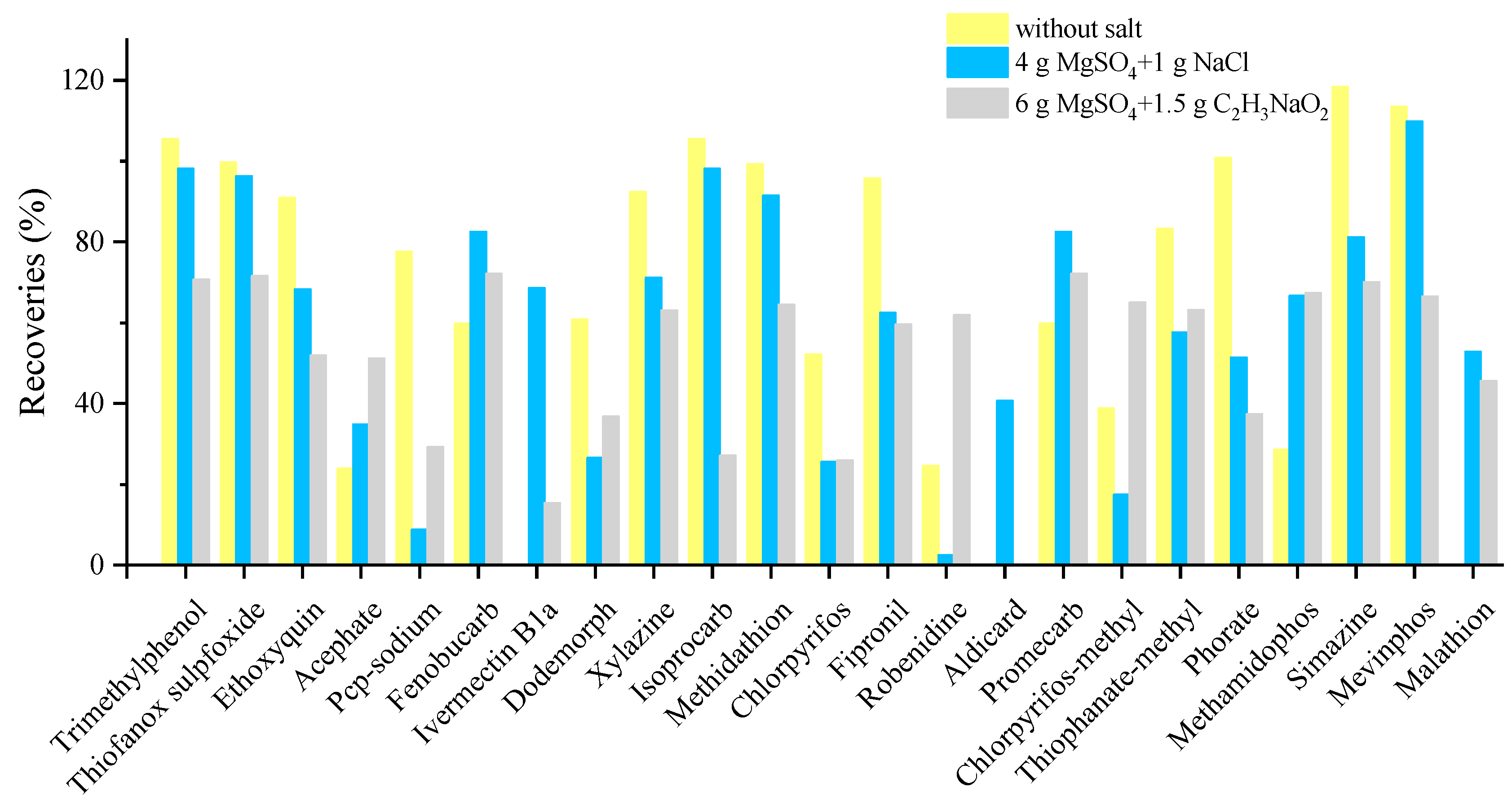
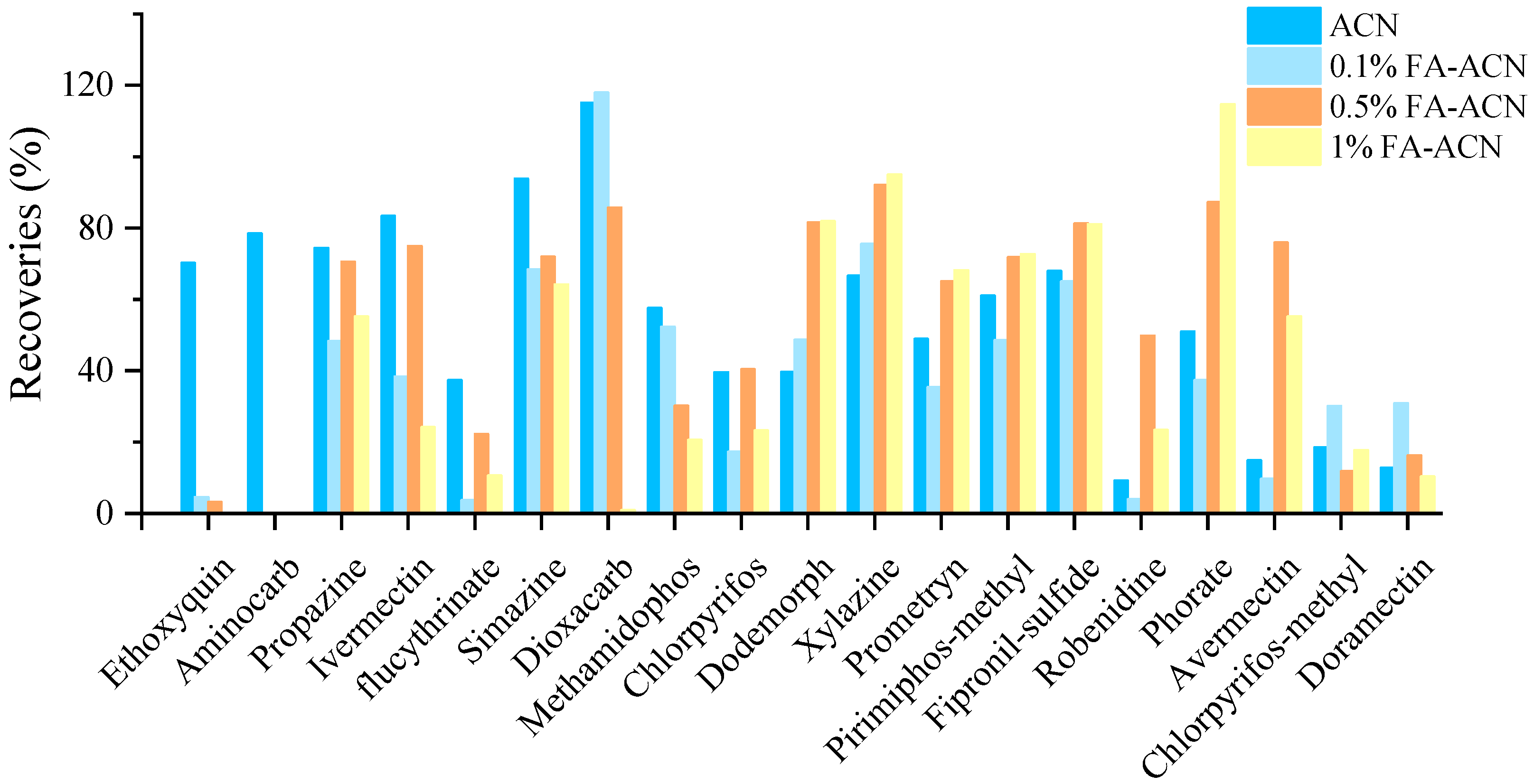
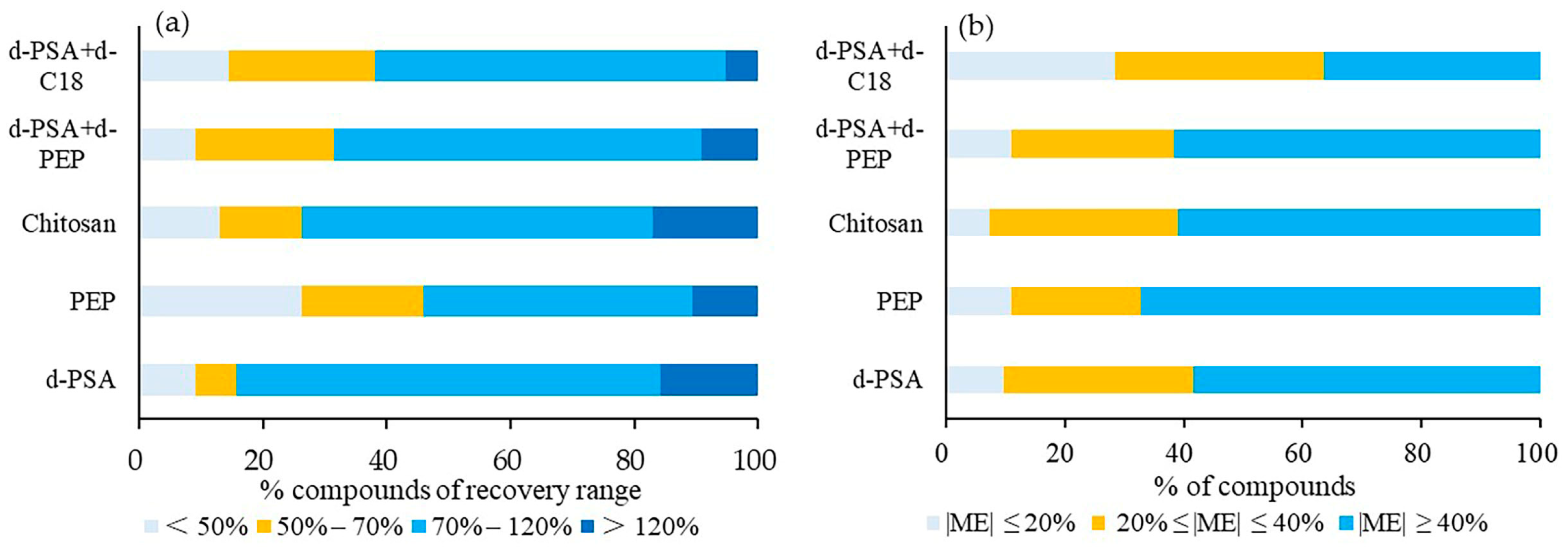
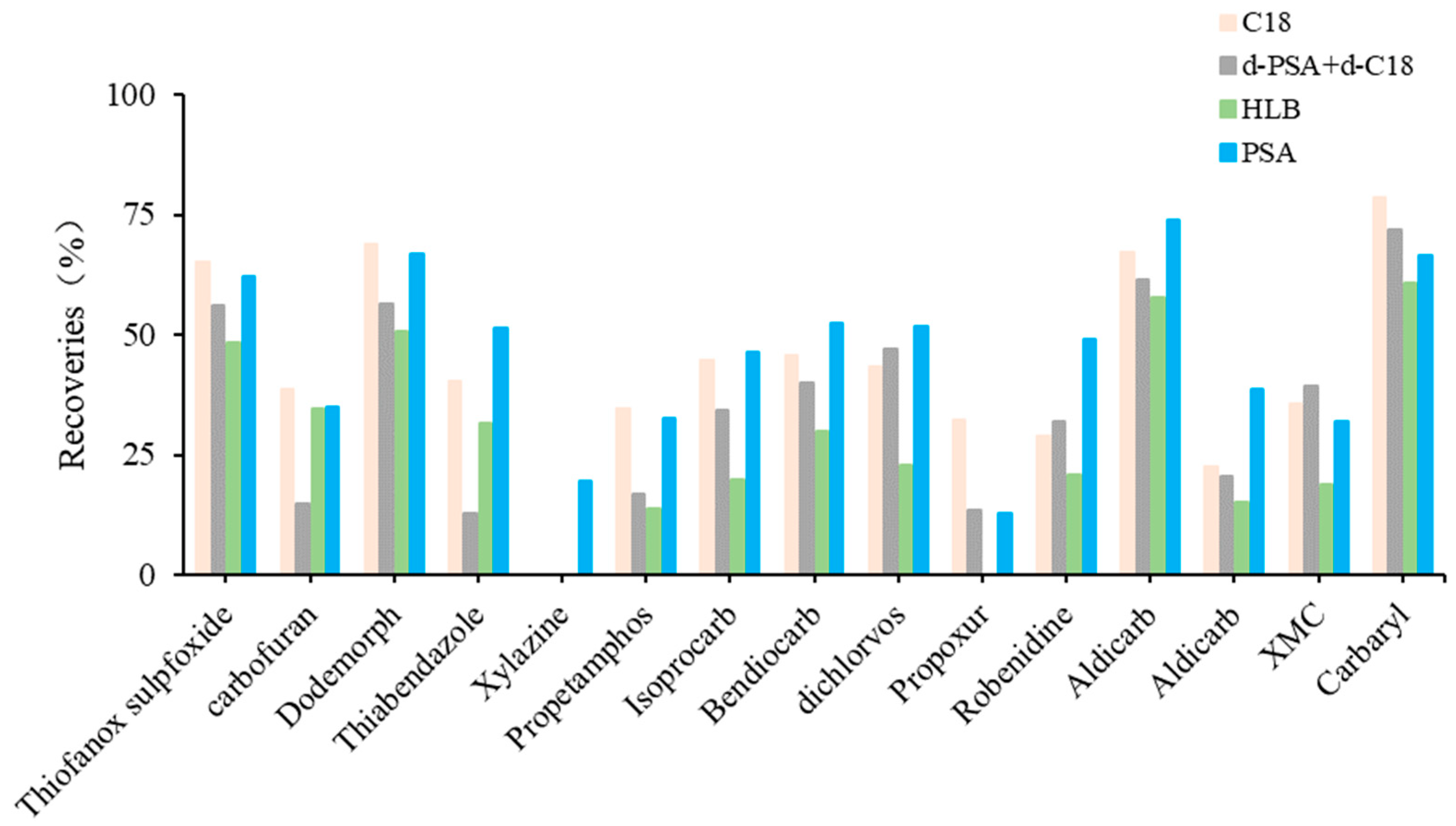
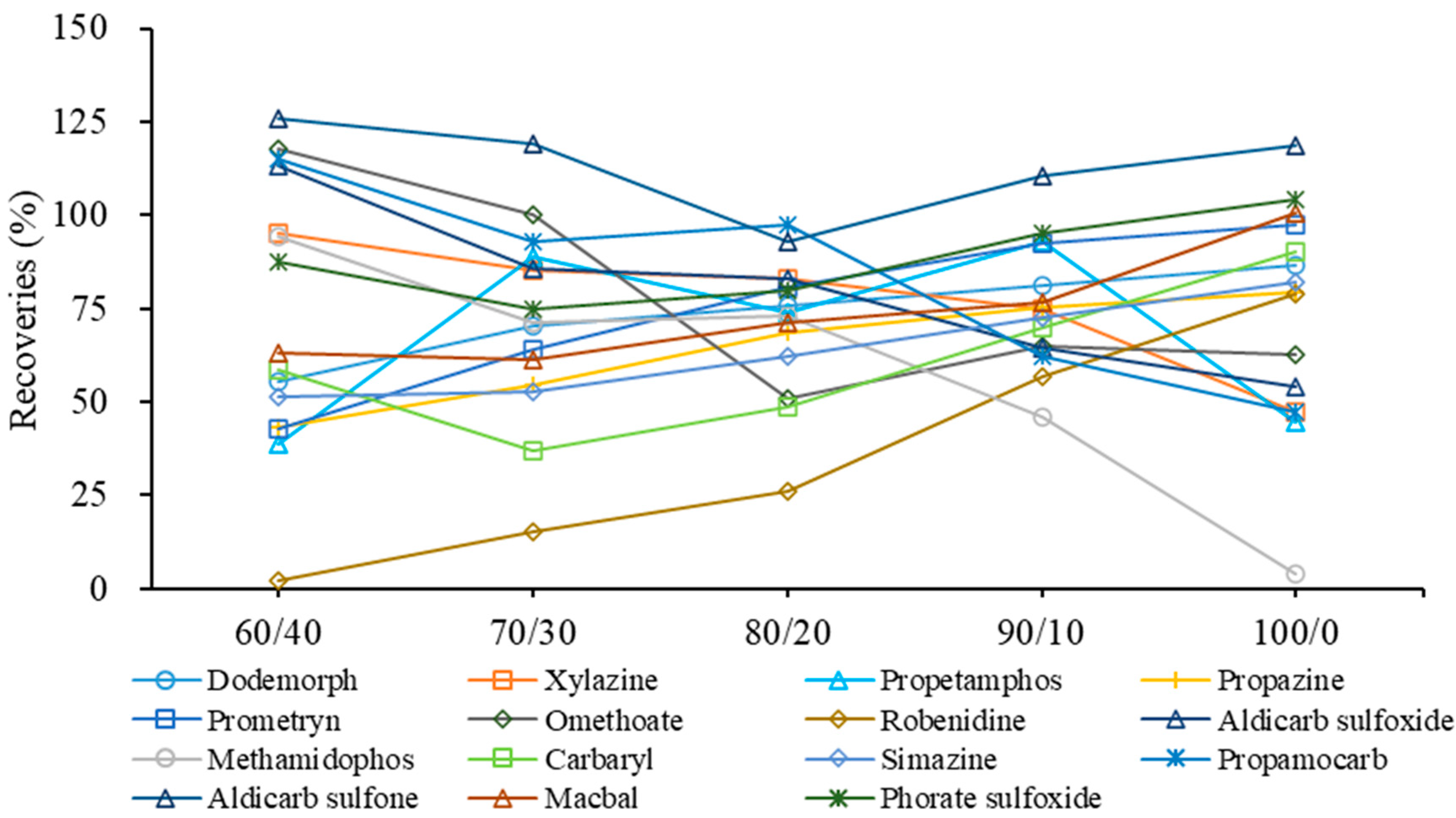
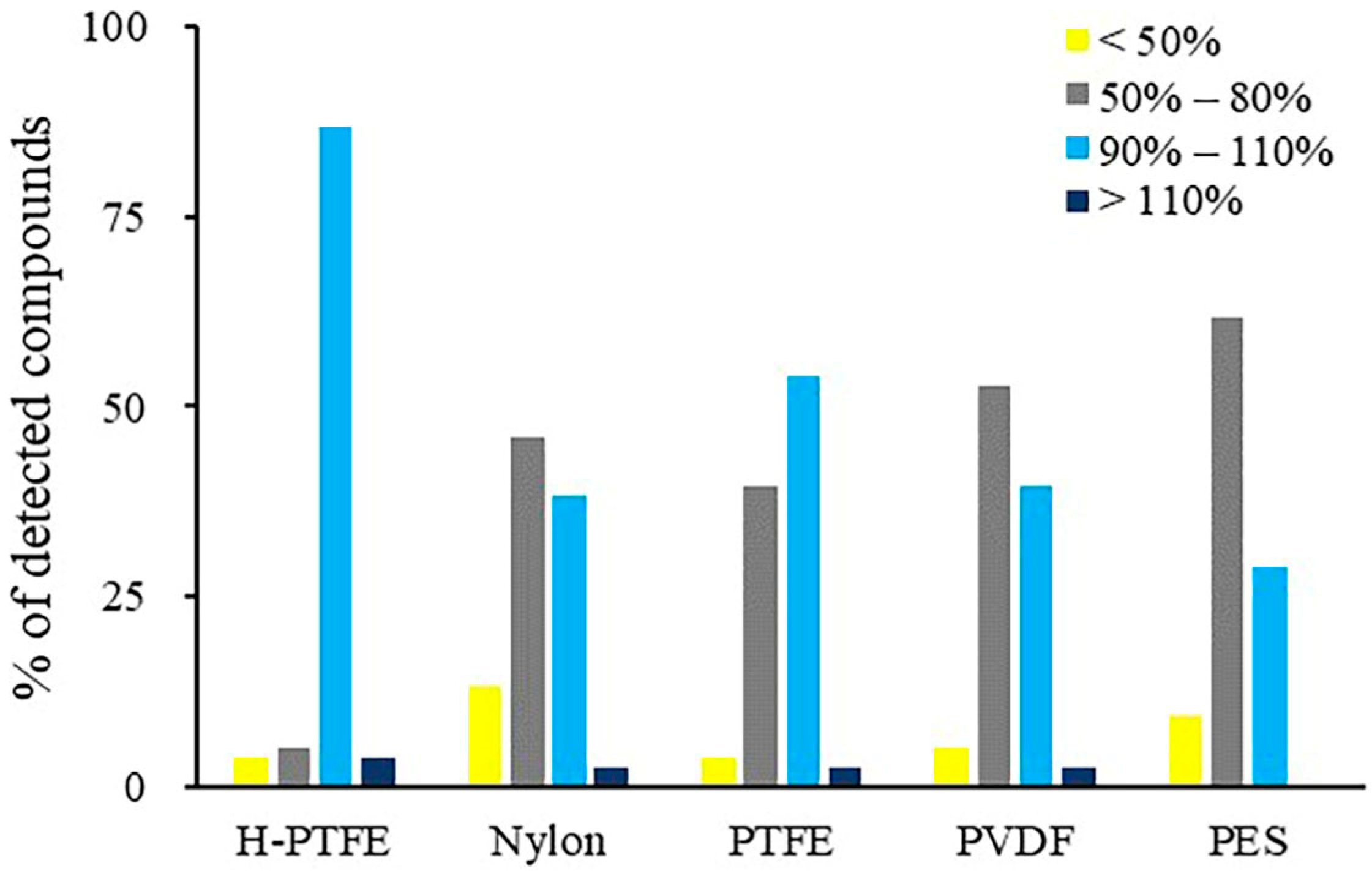

| No. | Sample Name | Content/μg/kg * (Screened Pesticide) |
|---|---|---|
| 1 | LitopenaeusVannamei | 0.065 (carbendazim), 0.39 (prometryn) |
| 2 | LitopenaeusVannamei | 0.11 (fipronil-sulfone), 0.047 (dodemorph), 0.098 (tributyl phosphorotrithioate) |
| 3 | LitopenaeusVannamei | 0.019 (carbendazim), 0.099 (fipronil-sulfone), 0.038 (phoxim) |
| 4 | LitopenaeusVannamei | ND |
| 5 | Eriocheirsinensis | 0.031 (carbendazim), 0.021 (fuberidazole), 0.19 (fenobucarb), 0.025 (2,3,5-trimethacarb) |
| 6 | Eriocheirsinensis | ND |
| 7 | Eriocheirsinensis | ND |
| 8 | Eriocheirsinensis | 0.019 (carbendazim), 0.094 (phoxim) |
| 9 | Eriocheirsinensis | 0.38 (phoxim) |
| 10 | Eriocheirsinensis | ND |
| 11 | Eriocheirsinensis | 0.024 (carbendazim) |
| 12 | Eriocheirsinensis | 0.015 (carbendazim), 0.059 (2,3,5-trimethacarb) |
| 13 | Eriocheirsinensis | 0.082 (phoxim) |
| 14 | Eriocheirsinensis | 0.060 (phoxim) |
| 15 | Ctenopharyngodonidella | 0.13 (carbendazim) |
| 16 | Ctenopharyngodonidella | 0.30 (ethoxyquin) |
| 17 | Carassius auratus | 0.62 (propoxur) |
| 18 | Ctenopharyngodonidella | 0.039 (fipronil-sulfone), 0.078 (fipronil-desulfiny), l0 (pirimiphos-methy), 0.29 (dodemorph), 0.11 (prometryn), 1.39 (phoxim), 472 (ethoxyquin) |
| 19 | Carassius auratus | ND |
| 20 | Carassius auratus | 0.16 (prometryn) |
| 21 | Carassius auratus | 0.39 (propoxur) |
| 22 | Hemiculterleucisculus | 0.051 (prometryn) |
| 23 | Ctenopharyngodonidella | 1.47 (prometryn) |
| 24 | Ctenopharyngodonidella | ND |
| 25 | Ctenopharyngodonidella | 0.063 (prometryn), 21 (ethoxyquin) |
| 26 | Ctenopharyngodonidella | 0.78 (ethoxyquin) |
| 27 | Ctenopharyngodonidella | 0.065 (carbendazim), 0.39 (prometryn) |
| 28 | Ophiocephalusargus | 0.11 (carbendazim), 0.073 (fipronil-sulfone), 0.094 (prometryn) |
| 29 | Ctenopharyngodonidella | 0.49 (ethoxyquin) |
| 30 | Ctenopharyngodonidella | 4.87 (trichlorfon), 6.81 (ethoxyquin) |
Disclaimer/Publisher’s Note: The statements, opinions and data contained in all publications are solely those of the individual author(s) and contributor(s) and not of MDPI and/or the editor(s). MDPI and/or the editor(s) disclaim responsibility for any injury to people or property resulting from any ideas, methods, instructions or products referred to in the content. |
© 2023 by the authors. Licensee MDPI, Basel, Switzerland. This article is an open access article distributed under the terms and conditions of the Creative Commons Attribution (CC BY) license (https://creativecommons.org/licenses/by/4.0/).
Share and Cite
Wang, S.; Yang, G.; Tang, Y.; Wang, Y.; Shen, X.; Si, W.; Yu, H.; Zhai, W.; Fodjo, E.K.; Kong, C. Multi-Residue Screening of Pesticides in Aquatic Products Using High-Performance Liquid Chromatography-Tandem High-Resolution Mass Spectrometry. Foods 2023, 12, 1131. https://doi.org/10.3390/foods12061131
Wang S, Yang G, Tang Y, Wang Y, Shen X, Si W, Yu H, Zhai W, Fodjo EK, Kong C. Multi-Residue Screening of Pesticides in Aquatic Products Using High-Performance Liquid Chromatography-Tandem High-Resolution Mass Spectrometry. Foods. 2023; 12(6):1131. https://doi.org/10.3390/foods12061131
Chicago/Turabian StyleWang, Shouying, Guangxin Yang, Yunyu Tang, Yuan Wang, Xiaosheng Shen, Wenshuai Si, Huijuan Yu, Wenlei Zhai, Essy Kouadio Fodjo, and Cong Kong. 2023. "Multi-Residue Screening of Pesticides in Aquatic Products Using High-Performance Liquid Chromatography-Tandem High-Resolution Mass Spectrometry" Foods 12, no. 6: 1131. https://doi.org/10.3390/foods12061131






